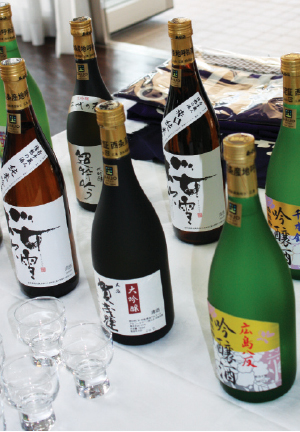 The long history of Japanese sake is one that continues to be hotly debated among connoisseurs of the revered beverage. While some claim that sake has been with us for about 2,000 years, others believe that Japanese sake, in its current incarnation, has existed for about 1,000 years. Either way, the history of sake stretches far longer than the culinary delicacies of most cultures alive today. Unlike wine, a beverage perfected by the French, sake is generally consumed soon after production rather than letting it age for many years. Although warm sake is a favorite among many non-Japanese taking their first taste of the drink, most experts acknowledge that it is usually the cold or slightly chilled sake that ranks among the top of the class.
The long history of Japanese sake is one that continues to be hotly debated among connoisseurs of the revered beverage. While some claim that sake has been with us for about 2,000 years, others believe that Japanese sake, in its current incarnation, has existed for about 1,000 years. Either way, the history of sake stretches far longer than the culinary delicacies of most cultures alive today. Unlike wine, a beverage perfected by the French, sake is generally consumed soon after production rather than letting it age for many years. Although warm sake is a favorite among many non-Japanese taking their first taste of the drink, most experts acknowledge that it is usually the cold or slightly chilled sake that ranks among the top of the class.
There are several types of sake that fall into two main categories. First, there is Daiginjo-shu, Ginjo-shu, and Honjozo-shu, which are brewed using rice, water, koji mold and distilled alcohol. Then there is Junmai-Daiginjo-shu, Junmai-Ginjo-shu, and Junmai-shu, which are brewed using only rice, water and koji mold. While most sake is 16 percent alcohol, the actual strength of the sake usually varies according to the brewery producing the drink. Although most sake can be left unrefrigerated, there is a kind of unpasteurized sake called nama-zake that should be refrigerated to preserve its taste and potency.
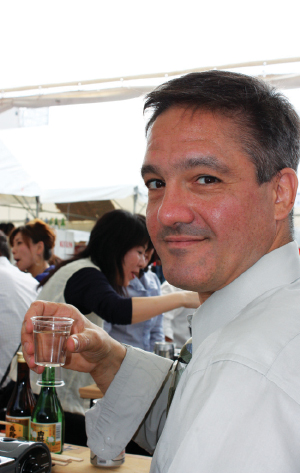 A new initiative launched by the government of Japan has shed special light on the Saijo region of Hiroshima, an area festooned with sake breweries and steeped in old world sake culture. Saijo Sake (www.saijosake.com) was recently picked as the first sake brand of the Japan Brand Development Assistance Program, a Japanese government initiative to promote Japanese products that feature local resources and traditional skills. Surrounded by a majestic ring of mountains, the Saijo region has been brewing some of Japanís finest sake since 1650.
A new initiative launched by the government of Japan has shed special light on the Saijo region of Hiroshima, an area festooned with sake breweries and steeped in old world sake culture. Saijo Sake (www.saijosake.com) was recently picked as the first sake brand of the Japan Brand Development Assistance Program, a Japanese government initiative to promote Japanese products that feature local resources and traditional skills. Surrounded by a majestic ring of mountains, the Saijo region has been brewing some of Japanís finest sake since 1650.
Saijo’s local wells have become famous for the purity of the water that lends itself to producing incredibly rich and varied brands of sake. In just one tiny enclave, ten sake breweries compete with all of Japan to continue to produce only top grade sake. Each brewery has its own style, flavor and approach, generally lorded over by a detail-oriented brew master obsessed with making his product the best among many would-be great sake brands.
The initiative has also given birth to a special English logo and slogan (“Taste Japan”), both designed to attract English speaking foreigners less familiar with the varieties and peculiarities of Japanese sake. In order for the associated breweries to lay claim to the Saijo pedigree, the brewery must adhere to a set of strict guidelines including: The sake must be made using Hiroshima’s traditional three-stage brewing process, it must be made with 100 percent Hiroshima-grown sake rice, it must be brewed with water from wells maintained by the breweries, the rice must be milled and polished to 50 percent or less for ginjo, and 60 percent or less for junmai, and finally the sake must pass a rigorous blind taste test, by an appointed judging panel, for overall quality.
Despite the incredibly serious nature of the sake production, in Saijo the work appears to be largely a family affair with generations of fathers, sons and daughters all chipping in to create a legacy of family sake designed to stand up to even the toughest critics throughout Japan. By name, the local breweries include: Kamotsuru, Kamoizumi, Fukubijin, Kirei, Saijotsuru, Sanyotsuru, Hakubotan, Kamoki, Sakurafubuki, and Chiyonoharu.
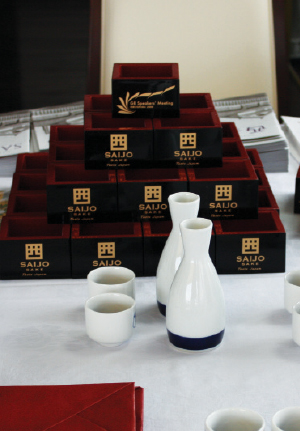 On a recent trip to the Saijo region, we experienced the area’s annual Sake Matsuri (more information at www.sakematsuri.com). Starting from very early in the morning, thousands of sake fans waited patiently on the perimeter of the festival grounds hoping to score some of the more choice and hard to find brands of sake on display. The festivities kicked off with a grand show of sake power by the brewers of Saijo in a parade called the Oosugidama Mikoshi.
On a recent trip to the Saijo region, we experienced the area’s annual Sake Matsuri (more information at www.sakematsuri.com). Starting from very early in the morning, thousands of sake fans waited patiently on the perimeter of the festival grounds hoping to score some of the more choice and hard to find brands of sake on display. The festivities kicked off with a grand show of sake power by the brewers of Saijo in a parade called the Oosugidama Mikoshi.
During this parade a portable shrine is carried throughout the town as the Saijo brewers proudly make their way through the streets beaming while sake fans look on in anticipation of the day’s sake selection.
Other activities that day would see child dance troupes, and singers all performing for attendees enjoying nabe dishes and the finest sake in Japan. Particular to Saijo is a kind of nabe called Bishu Nabe, a mixture of chicken, vegetables, salt, pepper and other ingredients, all boiled in sake. Throughout the weekend Maegaki-san, the head of the Saijo Sake Brewers Association and President of Kamoizumi Brewery, graciously introduced us to the many historic charms, sake technology, and overall sake culture that makes the area unique. An expressive and charming sake ambassador, Maegaki-san’s sake knowledge is so extensive he could literally teach a university graduate course on the subject—without notes!
Another welcome treat was the appearance of American sake expert John Gauntner (www.sake-world.com). Originally from Ohio, Gaunter (who speaks and reads Japanese fluently) has lived in Japan for many years promoting sake culture. In addition to publishing five books on the subject of sake, he also bears the distinction of being the only non-Japanese person to sit on the panel of the Award for the Promotion of Japanese Cuisine Overseas, an award assessed by the Ministry of Forestry and Fisheries in Japan.
Such a high honor bestowed upon a non-Japanese tongue is proof of Gaunter’s expertise. Gauntner deftly guided us through an intense battery of sake tasting that ranged from the light and sweet to the downright bitter, all with a sure hand and vivid descriptions that helped illuminate some of the more mysterious aspects of sake for our mostly untrained palates.
Tours of the sake breweries and the surrounding town are available by contacting the Hiroshima Intrepreter & Guide Association (English & German available) at www.j-higa.net, or by calling 082-245-8346. If you want to engage in the full experience of the location by staying in a traditional ryokan, you can contact www.fuji-noya.jp (Japanese only, but the interpreters can help if you contact them first). Access is relatively easy: from Hiroshima Airport take a bus (15 minutes) to Shiramachi Station on the JR Sanyo Line, after a quick 10 minute ride you get off at Saijo Station; via train simply travel to Hiroshima Station on the JR Sanyo Line and get off at Saijo Station.
By Adario Strange
From WINING & DINING in TOKYO #35

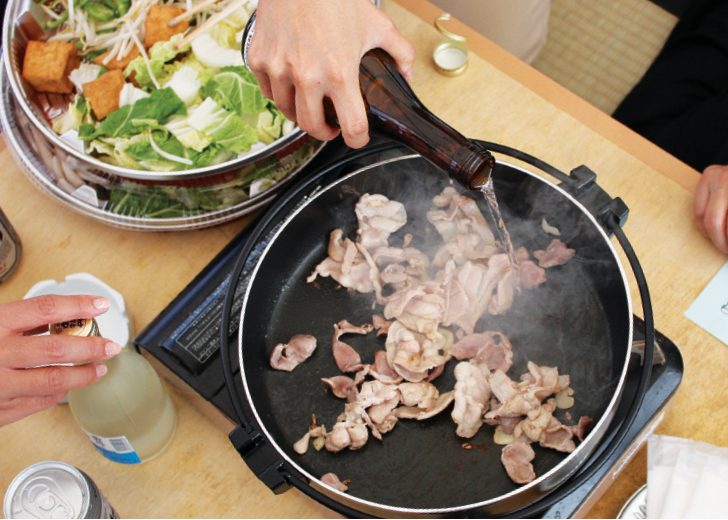

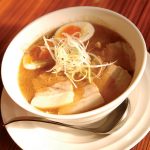
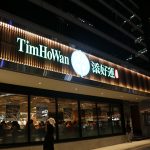
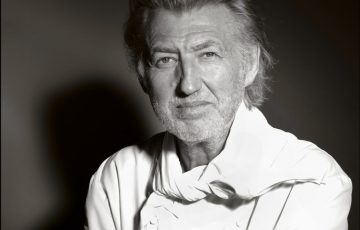
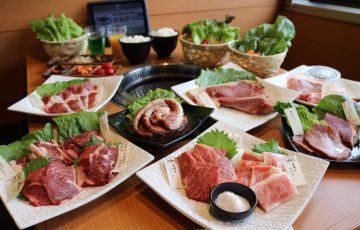

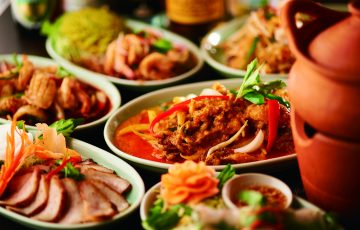
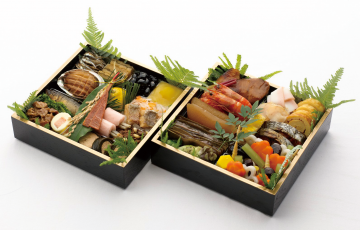

-360x230.jpg)
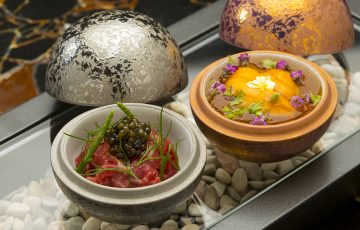


Recent Comments